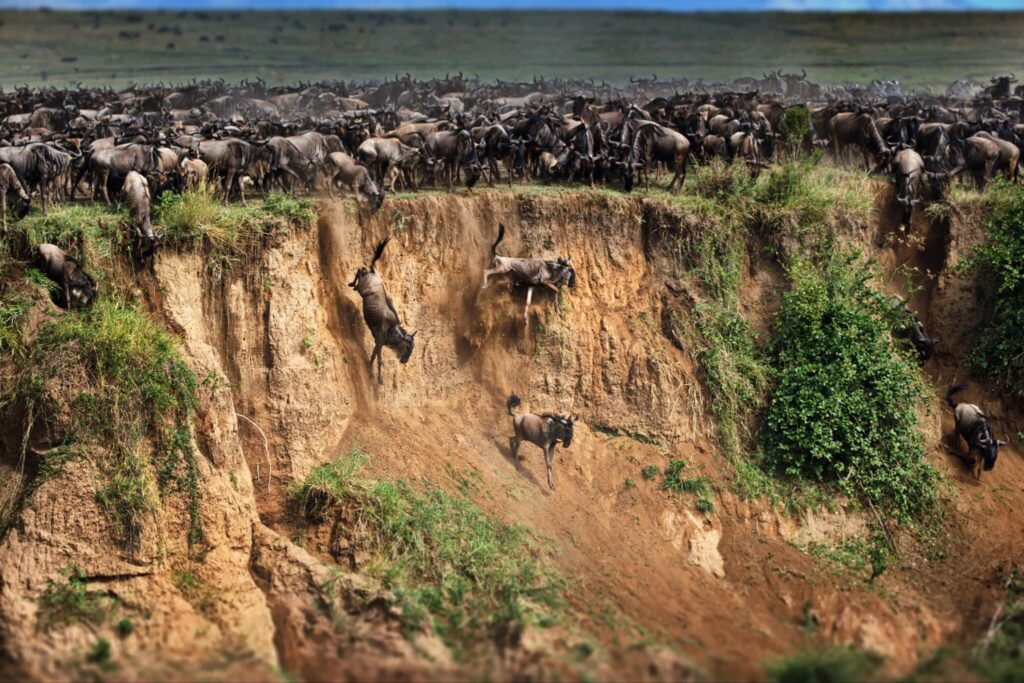How the Wildebeest Migration Works 2025/2026 is one of nature’s most impressive spectacles, where over 1.5 million wildebeest, along with hundreds of thousands of zebras and gazelles, travel across the Serengeti and Maasai Mara ecosystems. This massive movement of animals follows a circular route through Tanzania and Kenya, driven by the search for fresh grazing and water. Understanding How the Wildebeest Migration Works 2025/2026 helps travelers plan their safari to witness this incredible journey.

1. What Is the Wildebeest Migration? How the Wildebeest Migration Works 2025/2026
The wildebeest migration is a natural phenomenon that occurs annually in East Africa. The migration is driven by the seasonal rains and the availability of grazing pastures. Throughout the year, millions of wildebeest, zebras, and gazelles move in a continuous cycle across the Serengeti in Tanzania and the Maasai Mara in Kenya, facing numerous challenges such as river crossings and predator encounters.
Key Aspects of the Migration:
- Distance covered: The migration spans about 1,200 miles.
- Duration: The migration is continuous throughout the year, with different stages offering unique wildlife experiences.
- Animals involved: Over 1.5 million wildebeest, 400,000 zebras, and smaller groups of gazelles participate.
Read more about the wildebeest migration.
2. The Migration Cycle Explained (How the Wildebeest Migration Works 2025/2026)
The wildebeest migration follows a year-round cycle that is broken down into different phases. Each phase corresponds to specific locations and activities of the migrating herds, making it crucial to understand when planning a safari for 2025 or 2026.
January to March: Calving Season in the Southern Serengeti
From January to March, the herds are concentrated in the Southern Serengeti and the Ngorongoro Conservation Area. During this time, over 500,000 calves are born within a few weeks, attracting predators like lions, cheetahs, and hyenas.
- Location: Southern Serengeti, Ndutu region, Ngorongoro Conservation Area.
- Best for: Witnessing calving and predator-prey interactions.
- Weather: The area is lush and green due to the short rains.
Learn more about the calving season in the Serengeti.

April to June: The Long Rains and Migration Northward
As the rains continue, the herds begin to move north towards the Western Corridor of the Serengeti, seeking new pastures. This period can be challenging for the animals as they face predators and the onset of the long rains.
- Location: Western Serengeti and Grumeti Reserve.
- Best for: Seeing the herds on the move and smaller river crossings.
- Weather: Wet conditions may make some roads challenging for travel.
Find out more about visiting the Western Serengeti.
July to September: The Dramatic River Crossings
From July to September, the herds reach the Grumeti and Mara rivers, where they must cross these treacherous waters to reach the lush grasslands of the Maasai Mara in Kenya. The river crossings are among the most dramatic and dangerous parts of the migration, as crocodiles lie in wait for the crossing herds.
- Location: Grumeti River, Mara River, Maasai Mara.
- Best for: Witnessing dramatic river crossings and predator activity.
- Weather: Dry season, making it ideal for safari game drives.
Discover more about river crossings in the Serengeti.
October to November: Return to the Serengeti
By October, the herds start to return southward from the Maasai Mara into the Northern Serengeti as they follow the rains back to Tanzania. This period is often less crowded, providing a more relaxed safari experience.
- Location: Northern Serengeti, Maasai Mara border.
- Best for: Seeing the herds move back into the Serengeti with fewer tourists.
- Weather: Short rains begin in November, bringing greenery back to the plains.
Learn more about the northern migration back into Tanzania.
December: The Southern Serengeti Rebirth
As the herds settle back in the Southern Serengeti in December, the cycle begins anew. The short rains create a lush landscape, providing ample food for the herds and setting the stage for the next calving season.
- Location: Southern Serengeti and Ndutu region.
- Best for: Scenic landscapes and preparing for the calving season.
- Weather: Short rains provide a refreshing change to the landscape.
Read more about December safaris in the Serengeti.
3. Best Times to Witness the Migration in 2025/2026
While the migration is a year-round event, the best time to witness specific parts depends on the stage you wish to see. Here’s a breakdown of the ideal months for different migration events:
Key Events and Best Times:
- Calving Season: January to March in the Southern Serengeti.
- River Crossings: July to September at the Mara River.
- Return South: October to November in the Northern Serengeti.
Learn more about planning your migration safari.
4. Safari Packages for the 2025/2026 Migration
Several safari packages are designed to align with the wildebeest migration, offering travelers the chance to see specific events like the river crossings or calving season. Here’s what to expect from a 2025/2026 migration safari package:
7-Day Great Migration Safari
This package focuses on witnessing the river crossings and exploring the Northern Serengeti.
- Highlights: Game drives along the Mara River, opportunities to witness crossings, and excellent predator sightings.
- Best time: July to September.
Read more about 7-day migration safaris.
5-Day Calving Season Safari
A shorter option that focuses on the Southern Serengeti during the calving season.
- Highlights: Witness thousands of newborn wildebeest, intense predator action, and stunning green landscapes.
- Best time: January to March.
Find out more about calving season safaris.
5. Planning Your Migration Safari with Local Experts
Choosing the right guide or tour operator ensures that you maximize your chances of seeing the migration. Eddy Tours & Safaris offers customized packages for the 2025-2026 migration, tailored to provide the best possible sightings and experiences. From guided tours to luxury camping options, they make sure your safari is both comfortable and thrilling.
For those interested in adding a Mount Kilimanjaro climb to their itinerary, Kilimanjaro Climb Specialist offers combined packages that include both the migration and an ascent of Africa’s highest peak.
Start planning your migration safari today with expert guidance.
6. What to Pack for a Migration Safari
Packing the right gear for a migration safari is essential for comfort and safety. Due to varying temperatures and weather conditions, it’s important to be well-prepared.
Essential Packing List:
- Layered clothing: Lightweight layers for the day, warm layers for cool evenings.
- Binoculars: Essential for getting a close-up view of wildlife.
- Sun protection: Sunglasses, a hat, and sunscreen.
- Camera with zoom lens: To capture the action of the migration and the stunning landscapes.
Read more about what to pack for a safari.
7. Accommodation Options During the Migration
From luxury lodges to mobile camps, there are plenty of accommodation options that follow the migration patterns, ensuring you stay close to the action.
Top Picks:
- Luxury: Sayari Camp, offering luxury tents in the Northern Serengeti.
- Mid-range: Kati Kati Tented Camp, a great option for those seeking comfort and value.
- Budget: Public campsites in Serengeti National Park, ideal for travelers on a budget.
Find out more about where to stay during the migration.
Conclusion: Plan Your 2025/2026 Migration Safari
Understanding How the Wildebeest Migration Works 2025/2026 is key to planning a successful safari in 2025/2026. With the right timing, destinations, and guides, you can witness one of the most spectacular wildlife events on earth. For expert guidance, contact Eddy Tours & Safaris, or explore adventure packages with Kilimanjaro Climb Specialist for an extended Tanzanian adventure.

